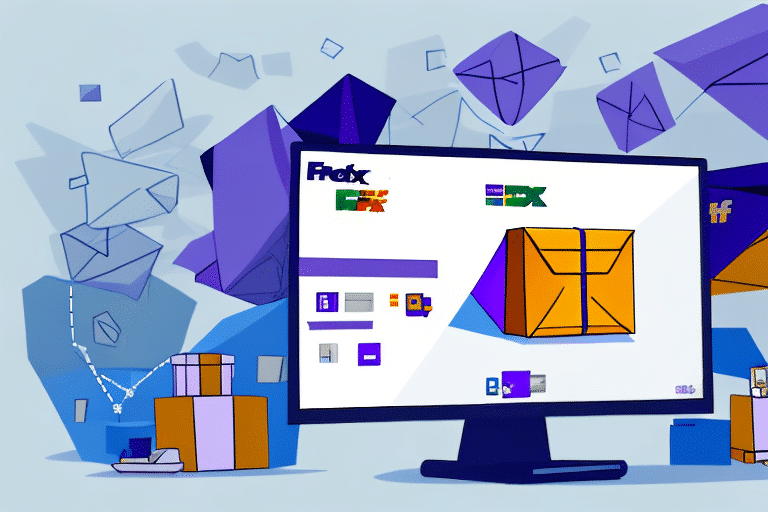Integrating FedEx Ship Manager with ACE for Maximum Efficiency
If you're a business owner looking to streamline your shipping processes, integrating FedEx Ship Manager with ACE is a smart choice. This integration can help you achieve maximum efficiency and reduce shipping errors. In this article, we'll explore the benefits of integrating FedEx Ship Manager with ACE and provide you with a step-by-step guide on how to set it up. We'll also discuss the role of ACE in international shipping processes, the features of FedEx Ship Manager that make it ideal for e-commerce businesses, and how to troubleshoot common integration issues. Let's dive in.
Understanding the Benefits of Integrating FedEx Ship Manager with ACE
The benefits of integrating FedEx Ship Manager with ACE are numerous. First and foremost, it helps reduce shipping errors by allowing you to automate the process of filling out customs forms and labels. This automation can save you time and money by minimizing the risk of mistakes and delays.
Additionally, integrating FedEx Ship Manager with ACE enables you to generate accurate shipping documentation and comply with customs regulations for international shipments. According to the U.S. Customs and Border Protection, proper documentation is crucial for avoiding costly penalties and delays at the border. Other benefits include enhanced tracking capabilities, improved visibility into shipping costs, and the ability to optimize your shipping processes for maximum efficiency.
- Automated customs documentation
- Enhanced shipment tracking
- Optimized shipping costs
- Improved compliance with international regulations
How to Set Up FedEx Ship Manager and ACE Integration
Setting up FedEx Ship Manager and ACE integration is a straightforward process. Follow these steps to ensure a seamless setup:
- Create Accounts: Ensure you have active accounts with both FedEx Ship Manager and ACE.
- Access Integration Settings: Log in to your FedEx Ship Manager account and navigate to the integration settings.
- Enter ACE Credentials: Input your ACE account information as prompted.
- Complete Setup: Follow the on-screen instructions to finalize the integration. If you encounter issues, contact FedEx Customer Support for assistance.
One of the key advantages of this integration is streamlined customs clearance for international shipments. By submitting all necessary customs documentation electronically, you reduce the risk of errors and delays, ensuring compliance with international trade regulations.
The Role of ACE in Streamlining International Shipping Processes
ACE, or Automated Commercial Environment, is a government-run system designed to streamline the process of clearing goods through customs. Managed by U.S. Customs and Border Protection, ACE provides a single platform for submitting and receiving information related to customs clearance, significantly reducing the time and cost associated with international shipping.
Key benefits of using ACE include:
- Centralized Information: A single platform for all customs-related documentation.
- Real-Time Tracking: Monitor shipments in real-time and receive updates on delays or issues.
- Enhanced Security: Advanced security features like biometric authentication and risk assessment tools.
- Compliance Assurance: Ensure shipments comply with all relevant regulations to avoid penalties.
By integrating with ACE, FedEx Ship Manager leverages these benefits, providing businesses with a more efficient and secure international shipping process.
Benefits of Using FedEx Ship Manager for Small Business Owners
For small business owners, FedEx Ship Manager offers a range of benefits beyond just integration with ACE. Some of the key advantages include:
- Cost-Effective Shipping: Easily compare shipping rates and access discounted rates tailored for small businesses.
- Advanced Tracking: Real-time tracking and reporting capabilities enhance visibility into shipments.
- User-Friendly Interface: Intuitive tools and a user-friendly interface streamline the shipping process.
- Scheduled Pickups: Schedule package pickups directly from your location, saving you time and effort.
These features help small businesses manage their shipping processes more efficiently, reduce costs, and provide a reliable shipping experience for their customers.
Reducing Shipping Errors with FedEx Ship Manager and ACE Integration
Integrating FedEx Ship Manager with ACE is an effective strategy for reducing shipping errors. Here's how:
- Automated Documentation: Automatically fill out customs forms and labels, minimizing manual entry mistakes.
- Real-Time Data: Access real-time shipment data to monitor and address issues promptly.
- Address Validation: Utilize automated address validation to ensure accurate delivery information.
- Stored Shipping Information: Save frequently used shipping details to streamline future shipments.
According to a report by PwC, automation in shipping can reduce errors by up to 30%, leading to significant cost savings and improved customer satisfaction.
By leveraging these features, businesses can enhance the accuracy of their shipping processes, reduce costs, and improve overall efficiency.
The Importance of Regulatory Compliance in International Shipping
Regulatory compliance is a critical aspect of international shipping. Failure to comply with customs regulations can result in costly penalties and delays. Integrating FedEx Ship Manager with ACE helps ensure compliance by providing a centralized platform for managing all customs-related documentation.
Key compliance benefits include:
- Accurate Documentation: Generate and submit precise customs forms to meet regulatory requirements.
- Automated Updates: Stay informed about changes in customs regulations through automated system updates.
- Risk Management: Utilize ACE’s risk assessment tools to identify and mitigate potential compliance issues.
Maintaining compliance not only avoids penalties but also enhances your business's reputation and reliability in the global market.
Features of FedEx Ship Manager Ideal for E-commerce Businesses
E-commerce businesses have unique shipping needs that FedEx Ship Manager addresses effectively. Key features include:
- Bulk Order Management: Handle multiple orders simultaneously, improving efficiency during high-volume periods.
- Integration with E-commerce Platforms: Seamlessly integrate with platforms like Shopify and WooCommerce for streamlined order processing.
- Discounted Shipping Rates: Access competitive rates for high-volume shippers, reducing overall shipping costs.
- Advanced Tracking: Provide customers with real-time tracking updates, enhancing the customer experience.
These features help e-commerce businesses manage their shipping operations more effectively, reduce costs, and provide a superior experience for their customers.
Best Practices for Using FedEx Ship Manager with ACE
To maximize efficiency when using FedEx Ship Manager with ACE, consider the following best practices:
- Utilize Advanced Tracking: Monitor shipments in real-time to quickly address any issues that arise.
- Automate Address Validation: Reduce errors by using automated tools to verify delivery addresses.
- Leverage Reporting Tools: Analyze shipping data to identify cost-saving opportunities and optimize processes.
- Regularly Update Systems: Ensure that both FedEx Ship Manager and ACE are updated to the latest versions for optimal performance and security.
Adhering to these best practices can enhance the efficiency of your shipping operations, reduce costs, and improve customer satisfaction.
Strategies to Optimize Shipping Costs with FedEx Ship Manager and ACE Integration
Reducing shipping costs is a key goal for many businesses. Integrating FedEx Ship Manager with ACE can help you achieve this through various strategies:
- Access Discounted Rates: Take advantage of FedEx’s discounted rates for bulk shipments and small businesses.
- Choose Cost-Effective Shipping Methods: Select the most economical shipping options based on destination, weight, and delivery time.
- Utilize Real-Time Tracking Data: Identify inefficiencies and implement changes to reduce costs.
- Optimize Packaging: Use appropriate packaging to minimize size and weight, reducing shipping costs.
Additionally, advanced reporting tools in FedEx Ship Manager allow you to analyze shipping expenditures and identify areas where you can cut costs without compromising service quality.
Troubleshooting Common Issues When Integrating FedEx Ship Manager with ACE
While integrating FedEx Ship Manager with ACE is generally straightforward, you may encounter some common issues. Here’s a step-by-step guide to troubleshooting:
- Account Linking Issues: Ensure that your FedEx Ship Manager and ACE accounts are active and that you have entered the correct credentials during setup.
- Customs Form Errors: Double-check the information entered in customs forms for accuracy. Use ACE’s documentation guidelines to ensure compliance.
- Tracking Data Discrepancies: Verify that tracking numbers are correctly entered and that there are no delays in data synchronization between systems.
- Software Compatibility: Ensure that both FedEx Ship Manager and ACE are updated to the latest versions to avoid compatibility issues.
If issues persist, consult the FedEx Customer Support or refer to the official documentation provided by FedEx and ACE for more detailed troubleshooting steps.
Real-Life Case Studies: Impact of Integrating FedEx Ship Manager with ACE
Examining real-life case studies can provide valuable insights into the benefits of integrating FedEx Ship Manager with ACE. Here are a few examples:
Case Study 1: E-commerce Retailer
An online retailer integrated FedEx Ship Manager with ACE, resulting in a 25% reduction in shipping errors and a 15% decrease in overall shipping costs. Automated customs documentation streamlined international orders, allowing the retailer to expand into new markets efficiently.
Case Study 2: Small Manufacturing Business
A small manufacturer adopted the integration to manage bulk shipments. The enhanced tracking and reporting capabilities enabled better inventory management and timely deliveries, leading to a 20% increase in customer satisfaction.
Case Study 3: Subscription Box Service
A subscription box company used the integration to handle high-volume, recurring shipments. The ability to schedule pickups and access discounted rates led to significant cost savings and improved operational efficiency.
Future Trends in Shipping Technology and the Role of FedEx Ship Manager with ACE
As technology continues to evolve, new trends are shaping the future of shipping. Integrating FedEx Ship Manager with ACE positions businesses to leverage these advancements effectively:
- Artificial Intelligence: AI can enhance predictive analytics for better demand forecasting and inventory management.
- Internet of Things (IoT): IoT devices can provide real-time data on shipment conditions, improving transparency and security.
- Blockchain Technology: Blockchain can offer secure and transparent transaction records, enhancing trust and compliance in shipping operations.
- Automation and Robotics: Automated sorting and packaging systems can further reduce manual errors and increase efficiency.
Integrating FedEx Ship Manager with ACE ensures your shipping operations are well-equipped to adopt these technologies, maintaining competitive advantage and operational excellence.
Expert Insights on the Importance of Automation in Logistics Management
Automation plays a crucial role in achieving maximum efficiency in logistics management. Experts highlight several key benefits:
- Increased Accuracy: Automation reduces human errors in data entry and documentation.
- Time Savings: Automated processes accelerate shipment handling and documentation, allowing businesses to focus on core activities.
- Cost Reduction: By minimizing errors and inefficiencies, automation helps lower operational costs.
- Scalability: Automated systems can easily scale with business growth, handling increased shipping volumes without sacrificing performance.
By integrating FedEx Ship Manager with ACE, businesses can harness the power of automation to streamline their logistics processes, enhance accuracy, and achieve significant cost savings. This integration aligns with industry best practices and supports continuous improvement in shipping operations.






















